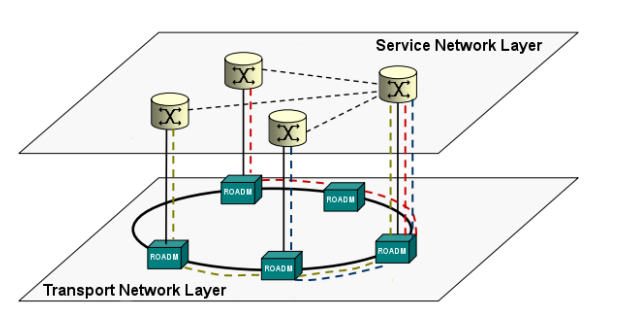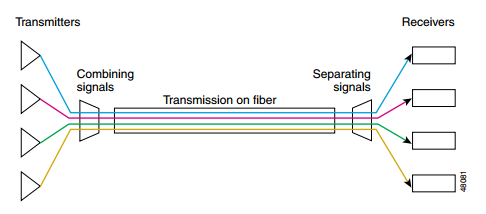- Related articles
- All Cisco ONS-SE-Z1's information (List price, Specs, Datasheet PDF)
- Optical Transceivers for Cisco WS-C2960+48TC-S Switch
- All Cisco ONS-SC+-10G-ER's information (List price, Specs, Datasheet PDF, Compatibility ma
- All Cisco XENPAK-10GB-LR+'s information (List price, Specs, Datasheet PDF, Compatibility m
- All Cisco XENPAK-10GB-LW's information (List price, Specs, Datasheet PDF, Compatibility ma
- The difference between GBIC and XFP
- All Cisco XENPAK-10GB-LR's information (List price, Specs, Datasheet PDF, Compatibility ma
- All Cisco SFP-OC12-LR1's information (List price, Specs, Datasheet PDF, Compatibility matr
- The difference between GBIC and CSFP
- All Cisco GLC-TA's information (Specs, Compatibility matrix)

Definition:
Dense Wavelength Division Multiplexing (DWDM) is an optical multiplexing technology used to increase bandwidth over existing fiber networks. DWDM works by combining and transmitting multiple signals simultaneously at different wavelengths on the same fiber. The technology creates multiple virtual fibers, thus multiplying the capacity of the physical medium.
ITU-T defines an Optical Transport Network (OTN) as a set of Optical Network Elements (ONE) connected by optical fiber links, able to provide functionality of transport, multiplexing, switching, management, supervision and survivability of optical channels carrying client signals.
Difference between DWDM and OTN
OTN optical transport networks are actually DWDM (dense wavelength division multiplexing) and ASON (Automatic Switched Optical Networks). First Huawei Transmission OTN with optical crossability, namely, by loading the WSS ROADM module, MESH network structure can make its composition is similar to that of the ASON equipment, improve the service scheduling flexibility, and increased network security; secondly, OTN electrical crossability, namely each channel sub rate crossability, this part and SDH the effects are similar, but the OTN frame has its own special structure, that is the 2.5G ODU1 particles and 10G particles of ODU2, there are also special for data service of ODU1E and ODU2E.+. Each of the DWDM channels is divided Bohebo and different function plates are required with pigtail connection, OTN can now be configured into port, don't use so much pigtail connection. Increasing the cross function, omitting the pigtail connection, more flexible and less fault point is more easily maintained.
Besides introducing the difference between DWDM and OTN, many people are confused about the functions of DWDM and what is OTN really used for, in order to solve these problems, we will briefly introduce the role of OTN and its work principle, which allows viewers better to know more about the DWDM and OTN.
The Role of OTN
Telecommunication networks can be divided into two networks: service network and transport network. The transport network provides paths to the service network, as so the service network can be seen as a client of the transport network.

How does G.709 OTN work?
At a basic level, G.709 OTN defines a frame format that "wraps" data packets, in a format quite similar to that of a SONET frame. There are six distinct layers to this format.
- OPU: Optical Channel Payload Unit. This contains the encapsulated client data, and a header describing the type of that data. It is analogous to the ‘Path’ layer in SONET/SDH.
- ODU: Optical Data Unit. This level adds optical path-level monitoring, alarm indication signals and automatic protection switching. It performs similar functions to the ‘Line Overhead’ in SONET/SDH.
- OTU: Optical Transport Unit. This represents a physical optical port (such as OTU2, 10Gbps), and adds performance monitoring (for the optical layer) and the FEC (Forward Error Correction). It is similar to the ‘Section Overhead’ in SONET/SDH.
- OCh: Optical Channel. This represents an end-to-end optical path.
- OMS: Optical Multiplex Section. This deals with fixed wavelength DWDM (Dense Wavelength Division Multiplexing) between OADMs (Optical Add Drop Multiplexer).
- OTS: Optical Transport Section. This deals with fixed wavelength DWDM between relays.
Functions of DWDM

The system performs the following main functions:
Generating the signal—The source, a solid-state laser, must provide stable light within a specific,narrow bandwidth that carries the digital data, modulated as an analog signal.
Combining the signals—Modern DWDM systems employ multiplexers to combine the signals.
There is some inherent loss associated with multiplexing and demultiplexing. This loss is dependent upon the number of channels but can be mitigated with optical amplifiers, which boost all the wavelengths at once without electrical conversion.
Transmitting the signals—The effects of crosstalk and optical signal degradation or loss must be reckoned with in fiber optic transmission. These effects can be minimized by controlling variables such as channel spacings, wavelength tolerance, and laser power levels. Over a transmission link,the signal may need to be optically amplified.
Separating the received signals—At the receiving end, the multiplexed signals must be separated
out. Although this task would appear to be simply the opposite of combining the signals, it is actually more technically difficult.
Receiving the signals—The demultiplexed signal is received by a photodetector.
In addition to these functions, a DWDM system must also be equipped with client-side interfaces to receive the input signal. This function is performed by transponders. On the DWDM side are interfaces to the optical fiber that links DWDM systems
Conclusion
While OTN has clearly taken many elements from previous network technology such as PDH and SONET/SDH, it is certainly a significant evolutionary step in transport technology. Service providers around the world have committed to OTN as their transport technology of choice and there are much time and energy being spent on developing new equipment to enable a greatly expanded rollout of OTN into the Service Provider networks.






















































